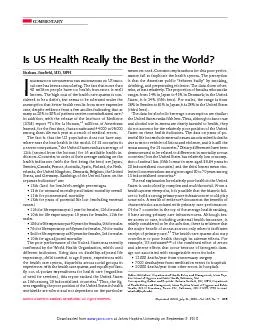/


IsUSHealthReallytheBestintheWorld BarbaraStarfieldMDMPH NFORMATIONCONCERNINGTHEDEFICIENCIESOFcalcarehasbeenaccumulatingThefactthatmorethan40millionpeoplehavenohealthinsuranceiswellknownThehighcos ID: 838189
Download Pdf The PPT/PDF document "COMMENTARY" is the property of its rightful owner. Permission is granted to download and print the materials on this web site for personal, non-commercial use only, and to display it on your personal computer provided you do not modify the materials and that you retain all copyright notices contained in the materials. By downloading content from our website, you accept the terms of this agreement.
1 COMMENTARY IsUSHealthReallytheBestintheW
COMMENTARY IsUSHealthReallytheBestintheWorld? BarbaraStarfield,MD,MPH NFORMATIONCONCERNINGTHEDEFICIENCIESOFcalcarehasbeenaccumulating.Thefactthatmorethan40millionpeoplehavenohealthinsuranceiswellknown.Thehighcostofthehealthcaresystemiscon-sideredtobeadeficit,butseemstobetoleratedundertheassumptionthatbetterhealthresultsfrommoreexpensivecare,despiteevidencefromafewstudiesindicatingthatasmanyas20%to30%ofpatientsreceivecontraindicatedcare.Inaddition,withthereleaseoftheInstituteofMedicine(IOM)reportªToErrIsHuman,ºmillionsofAmericanslearned,forthefirsttime,thatanestimated44000to98000amongthemdieeachyearasaresultofmedicalerrors.ThefactisthattheUSpopulationdoesnothaveany-wherenearthebesthealthintheworld.Of13countriesinarecentcomparison,theUnitedStatesranksanaverageof12th(secondfromthebottom)for16availablehealthin-dicators.Countriesinorderoftheiraveragerankingonthehealthindicators(withthefirstbeingthebest)areJapan,Sweden,Canada,France,Australia,Spain,Finland,theNeth-erlands,theUnitedKingdom,Denmark,Belgium,theUnitedStates,andGermany.RankingsoftheUnitedStatesontheseparateindicators·13th(last)forlow-birth-weightpercentages·13thforneonatalmortalityandinfantmortalityoverall·11thforpostneonatalmortality·13thforyearsofpotentiallifelost(excludingexternal·11thforlifeexpectancyat1yearforfemales,12thformales·10thforlifeexpectancyat15yearsforfemales,12thfor·10thforlifeexpectancyat40yearsforfemales,9thformales·7thforlifeexpectancyat65yearsforfemales,7thformales·3rdforlifeexpectancyat80yearsforfemales,3rdformales·10thforage-adjustedmortalityThepoorperformanceoftheUnitedStateswasrecentlyconfirmedbytheWorldHealthOrganization,whichuseddifferentindicators.Usingdataondisability-adjustedlifeexpectancy,childsurvivaltoage5years,experienceswiththehealthcaresystem,disparitiesacrosssocialgroupsinexperienceswiththehealthcaresystem,andequalityoffam-ilyout-of-pocketexpendituresforhealthcare(regardlessofneedforservices),thisreportrankedtheUnitedStatesas15thamong25industrializedcountries.Thus,thefig-uresregardingthepoorpositionoftheUnitedStatesinhealthworldwidearerobustandnotdependentontheparticularmeasuresused.Commonexplanationsforthispoorperfor-mancefailtoimplicatethehealthsystem.TheperceptionisthattheAmericanpublicªbehavesbadlyºbysmoking,drinking,andperpetratingviolence.Thedatashowother-wise,atleastrelatively.Theproportionoffemaleswhosmokerangesfrom14%inJapanto41%inDenmark;intheUnitedStates,itis24%(fifthbest).Formales,therangeisfrom26%inSwedento61%inJapan;itis28%intheUnitedStates(thirdbest).Thedataforalcoholicbeverageconsumptionaresimilar:theUnitedStatesranksfifthbest.Thus,althoughtobaccouseandalcoholuseinexcessareclearlyharmfultohealth,theydonotaccountfortherelativelypoorpositionoftheUnitedStatesonthesehealthindicators.Thedataonyearsofpo-tentiallifelostexcludeexternalcausesassociatedwithdeathsduetomotorvehiclecollisionsandviolence,anditisstilltheworstamongthe13countries.DietarydifferenceshavebeendemonstratedtoberelatedtodifferencesinmortalityacrossbuttheUnitedStateshasrelativelylowconsump-tionofanimalfats(fifthlowestinmenaged55-64yearsin20industrializedcountries)andthethirdlowestmeancho-lesterolconcentrationsamongmenaged50to70yearsamong13industrializedcountries.TherealexplanationforrelativelypoorhealthintheUnitedStatesisundoubtedlycomplexandmultifactorial.Fromahealthsystemviewpoint,itispossiblethatthehistoricfail-uretobuildastrongprimarycareinfrastructurecouldplaysomerole.Awealthofevidencedocumentsthebenefitsofcharacteristicsassociatedwithprimarycareperformance.Ofthe7countriesinthetopoftheaveragehealthranking,5havestrongprimarycareinfrastructures.Althoughbet-teraccesstocare,includinguniversalhealthinsurance,iswidelyconsideredtobethesolution,thereisevidencethatthemajorbenefitofaccessaccruesonlywhenitfacilitatesreceiptofprimarycare.Thehealthcaresystemalsomaycontributetopoorhealththroughitsadverseeffects.Forexample,USestimatesofthecombinedeffectoferrorsandadverseeffectsthatoccurbecauseofiatrogenicdam-agenotassociatedwithrecognizableerrorinclude:·12000deaths/yearfromunnecessarysurgery·7000deaths/yearfrommedicationerrorsinhospitals·20000deaths/yearfromothererrorsinhospitals AuthorAffiliation:DepartmentofHealthPolicyandManagement,JohnsHop-kinsSchoolofHygieneandPublicHealth,Baltimore,Md.CorrespondingAuthorandReprints:BarbaraStarfield,MD,MPH,DepartmentofHealthPolicyandManagement,JohnsHopkinsSchoolofHygieneandPublicHealth,624NBroadway,Room452,Baltimore,MD21205-1996(e-mail:2000AmericanMedicalAssociation.Allrightsreserved.July26,2000ÐVol284,No.4 ·80000deaths/yearfromnosocomialinfectionsin·106000deaths/yearfromnonerror,adverseeffectsofmedicationsThesetotalto225000deathsperyearfromiatrogeniccauses.Threecaveatsshouldbenoted.First,mostofthedataarederivedfromstudiesinhospitalizedpatients.Second,theseestimatesarefordeathsonlyanddonotincludead-verseeffectsthatareassociatedwithdisabili
2 tyordiscom-fort.Third,theestimatesofdeat
tyordiscom-fort.Third,theestimatesofdeathduetoerrorarelowerthanthoseintheIOMreport.Ifthehigherestimatesareused,thedeathsduetoiatrogeniccauseswouldrangefrom230000to284000.Inanycase,225000deathsperyearconstitutesthethirdleadingcauseofdeathintheUnitedStates,afterdeathsfromheartdiseaseandcancer.Evenifthesefiguresareoverestimated,thereisawidemarginbetweenthesenum-bersofdeathsandthenextleadingcauseofdeath(cere-brovasculardisease).Oneanalysisovercomessomeoftheselimitationsbyes-timatingadverseeffectsinoutpatientcareandincludingad-verseeffectsotherthandeath.Itconcludedthatbetween4%and18%ofconsecutivepatientsexperienceadverseef-fectsinoutpatientsettings,with116millionextraphysi-cianvisits,77millionextraprescriptions,17millionemer-gencydepartmentvisits,8millionhospitalizations,3millionlong-termadmissions,199000additionaldeaths,and$77billioninextracosts(equivalenttotheaggregatecostofcareofpatientswithdiabetes).AnotherpossiblecontributortothepoorperformanceoftheUnitedStatesonhealthindicatorsisthehighdegreeofincomeinequalityinthiscountry.Anextensiveliteraturedocumentstheenduringadverseeffectsoflowsocioeco-nomicpositiononhealth;anewerandaccumulatinglitera-turesuggeststheadverseeffectsnotonlyoflowsocialpo-sitionbut,especially,lowsocialpositioninindustrializedcountries.Amongthe13countriesin-cludedintheinternationalcomparisonmentionedabove,theUSpositiononincomeinequalityis11th(thirdworst).Swedenranksthebestonincomeequality(whenincomeiscalculatedaftertaxesandincludingsocialtransfers),match-ingitshighpositionforhealthindicators.Thereisanim-perfectrelationshipbetweenrankingsonincomeinequal-ityandhealth,althoughtheUnitedStatesistheonlycountryinapoorpositiononboth(B.S.,unpublisheddata,2000).Anintriguingaspectofthedataisthedifferencesinrank-ingforthedifferentagegroups.USchildrenareparticu-larlydisadvantaged,whereaselderlypersonsaremuchlessso.Judgingfromthedataonlifeexpectancyatdifferentages,theUSpopulationbecomeslessdisadvantagedasitages,buteventherelativelyadvantagedpositionofelderlyper-sonsintheUnitedStatesisslipping.TheUSrelativeposi-tionforlifeexpectancyintheoldestagegroupwasbetterinthe1980sthaninthe1990s.Thelong-existingpoorrank-ingoftheUnitedStateswithregardtoinfantmortalitybeenacauseforconcern;itisnotaresultofthehighper-centagesoflowbirthweightandinfantmortalityamongtheblackpopulation,becausetheinternationalrankinghardlychangeswhendataforthewhitepopulationonlyareused.Whereasdefinitiveexplanationsfortherelativelypoorpo-sitionoftheUnitedStatescontinuetobeelusive,therearesufficienthintsastotheirnaturetoprovidethebasisforconsiderationofneglectedfactors:(1)Thenatureandoperationofthehealthcaresystem.IntheUnitedStates,incontrasttomanyothercountries,theextenttowhichreceiptofservicesfromprimarycarephysiciansvsspecialistsaffectsoverallhealthandsurvivalhasnotbeenconsidered.Whileavailabledataindicatethatspecialtycareisassociatedwithbetterqualityofcareforspe-cificconditionsinthepurviewofthespecialist,thedataongeneralmedicalcaresuggestotherwise.Nationalsur-veysalmostallfailtoobtaindataontheextenttowhichthecarereceivedfulfillsthecriteriaforprimarycare,soitisnotpossibletoexaminetherelationshipsbetweenindividualandcommunityhealthcharacteristicsandthetypeofcarere-(2)Therelationshipbetweeniatrogeniceffects(includ-ingbotherrorandnonerroradverseevents)andtypeofcarereceived.TheresultsofinternationalsurveysdocumentthehighavailabilityoftechnologyintheUnitedStates.Among29countries,theUnitedStatesissecondonlytoJapanintheavailabilityofmagneticresonanceimagingunitsandcom-putedtomographyscannerspermillionpopulation.pan,however,rankshighestonhealth,whereastheUnitedStatesranksamongthelowest.ItispossiblethatthehighuseoftechnologyinJapanislimitedtodiagnostictechnol-ogynotmatchedbyhighratesoftreatment,whereasintheUnitedStates,highuseofdiagnostictechnologymaybelinkedtotheªcascadeeffectºandtomoretreatment.Sup-portingthispossibilityaredatashowingthatthenumberofemployeesperbed(full-timeequivalents)intheUnitedStatesishighestamongthecountriesranked,whereastheyareverylowinJapanfarlowerthancanbeaccountedforbythecommonpracticeofhavingfamilymembersratherthanhospitalstaffprovidetheamenitiesofhospitalcare.Howcauseofdeathandoutpatientdiagnosesarecodeddoesnotfacilitateanunderstandingoftheextenttowhichiatrogeniccausesofillhealthareoperative.ConsistentuseofªEºcodes(externalcausesofinjuryandpoisoning)wouldimprovethelikelihoodoftheirrecognitionbecausetheseInternationalClassificationofDiseases)codespermitattributionofcauseofeffecttoªDrugs,Medicinal,andBio-logicalSubstancesCausingAdverseEffectsinTherapeuticUse.ºMoreconsistentuseofcodesforªComplicationsofSurgicalandMedicalCareº(codes960-979and996-999)mightimprovetherecognitionofthemagnitudeoftheireffect;currently,mostdeathsresultingfromtheseunder-lyingcausesarelikelytobecodedaccordingtotheimme-diatecauseofdeath(suchasorganfailure).Thesugges-tionsoftheIOMdocumentonmandatory
3 reportingofadverseeffectsmightimproverep
reportingofadverseeffectsmightimprovereportinginhospitalset- July26,2000ÐVol284,No.42000AmericanMedicalAssociation.Allrightsreserved. tings,butitisunlikelytoaffectunderreportingofadverseeventsinnoninstitutionalsettings.Onlybetterrecordkeep-ing,withdocumentationofallinterventionsandresultinghealthstatus(includingsymptomsandsigns),islikelytoimprovethecurrentabilitytounderstandboththeadverseandpositiveeffectsofhealthcare.(3)Therelationshipsamongincomeinequality,socialdis-advantage,andcharacteristicsofhealthsystems,includingtherelativecontributionsofprimarycareandspecialtycare.Recentstudiesusingphysician-to-populationratios(asaproxyforunavailabledataonactualreceiptofhealthser-vicesaccordingtotheirtype)haveshownthatthehighertheprimarycarephysician±to±populationratioinastate,thebettermosthealthoutcomesare.Theinfluenceofspe-cialtyphysician±to±populationratiosandofspecialist±to±primarycarephysicianratioshasnotbeenadequatelystud-ied,butpreliminaryandrelativelysuperficialanalysessuggestthattheconversemaybethecase.Inclusionofincomein-equalityvariablesintheanalysisdoesnoteliminatetheposi-tiveeffectofprimarycare.Furthermore,statesthathavemoreequitabledistributionsofincomealsoaremorelikelytohavebetterprimarycareresourceavailability,thusraisingques-tionsabouttherelationshipsamongahostofsocialandhealthpolicycharacteristicsthatdeterminewhatandhowre-sourcesareavailable.Recognitionoftheharmfuleffectsofhealthcareinter-ventions,andthelikelypossibilitythattheyaccountforasubstantialproportionoftheexcessdeathsintheUnitedStatescomparedwithothercomparablyindustrializedna-tions,shedsnewlightonimperativesforresearchandhealthpolicy.Alternativeexplanationsfortheserealitiesdeserveintensiveexploration. SchusterM,McGlynnE,BrookR.HowgoodisthequalityofhealthcareintheUnitedStates?MilbankQ.1998;76:517-563.KohnL,CorriganJ,DonaldsonM,eds.ToErrIsHuman:BuildingaSaferHealth.Washington,DC:NationalAcademyPress;1999.StarfieldB.PrimaryCare:BalancingHealthNeeds,Services,andTechnologyNewYork,NY:OxfordUniversityPress;1998.WorldHealthReport2000.Availableat:http://www.who.int/whr/2000/en/report.htm.AccessedJune28,2000.KunstA.Cross-nationalComparisonsofSocioeconomicDifferencesinMor-.Rotterdam,theNetherlands:ErasmusUniversity;1997.LawM,WaldN.WhyheartdiseasemortalityislowinFrance:thetimelagex-.1999;313:1471-1480.StarfieldB.EvaluatingtheStateChildren'sHealthInsuranceProgram:criticalAnnuRevPublicHealth.2000;21:569-585.LeapeL.Unnecessarysurgery.AnnuRevPublicHealth.PhillipsD,ChristenfeldN,GlynnL.IncreaseinUSmedication-errordeathsbe-tween1983and1993..1998;351:643-644.LazarouJ,PomeranzB,CoreyP.Incidenceofadversedrugreactionsinhos-pitalizedpatients..1998;279:1200-1205.WeingartSN,WilsonRM,GibberdRW,HarrisonB.Epidemiologyandmedi-calerror.WilkinsonR.UnhealthySocieties:TheAfflictionsofInequality.London,En-gland:Routledge;1996.EvansR,RoosN.WhatisrightabouttheCanadianhealthsystem?GuyerB,HoyertD,MartinJ,VenturaS,MacDormanM,StrobinoD.AnnualsummaryofvitalstatisticsÐ1998.HarroldLR,FieldTS,GurwitzJH.Knowledge,patternsofcare,andoutcomesofcareforgeneralistsandspecialists.JGenInternMed.1999;14:499-511.DonahoeMT.Comparinggeneralistandspecialtycare:discrepancies,defi-ciencies,andexcesses.ArchInternMed.1998;158:1596-1607.AndersonG,PoullierJ-P.HealthSpending,Access,andOutcomes:TrendsinIndustrializedCountries.NewYork,NY:TheCommonwealthFund;1999.MoldJ,SteinH.Thecascadeeffectintheclinicalcareofpatients.NEnglJ.1986;314:512-514.ShiL,StarfieldB.Incomeinequality,primarycare,andhealthindicators.JFam.1999;48:275-284. EDITORIAL EditorialsrepresenttheopinionsoftheauthorsandTandnotthoseoftheAmericanMedicalAssociation.SexandCyberspaceÐVirtualNetworksLeadingtoHigh-RiskSex KathleenE.Toomey,MD,MPH RichardB.Rothenberg,MD NADDITIONTOITSPOWERANDREACHFORRAPIDINFORmationexchange,theInternethasgeneratedanewde-bate:doesitfundamentallychangethewayweleadourlives?ThattheInternethasrevolutionizedcommuni-cationsandbusinesspracticesworldwideisclearlyrecog-nized.ThattheInternetmayhavesomepsychologicalef-fectsonindividualbehavior,moldedperhapsbythetechnologyitself,hasnowbeennoted.Newlydescribedbe-havioraldisorderspossiblylinkedtoInternetuseincludeInternet-relateddepressionandcybersexaddiction.centreportshavesuggestedthatfullyonethirdofadultIn-ternetvisitsaredirectedtosexuallyorientedWebsites,chatrooms,andnewsgroups,whereInternetuserscanob-servesexualimagesorparticipateinonlinesexualdiscus- Seealsopp443and447. AuthorAffiliations:DivisionofPublicHealth,GeorgiaDepartmentofHumanRe-sources(DrToomey),andDepartmentofFamilyandPreventiveMedicine,EmoryUniversitySchoolofMedicine(DrRothenberg),Atlanta.CorrespondingAuthorandReprints:KathleenE.Toomey,MD,MPH,DivisionofPublicHealth,GeorgiaDepartmentofHumanResources,2PeachtreeStNW,Suite15-470,Atlanta,GA30303-3682(e-mail:ket1@dhr.state.ga.us). 2000AmericanMedicalAssociation.Allrightsreserved.July26,2000ÐVol284,No.